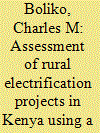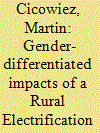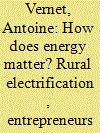|
|
|
Sort Order |
|
|
|
Items / Page
|
|
|
|
|
|
|
| Srl | Item |
| 1 |
ID:
125766


|
|
|
|
|
| Publication |
2013.
|
| Summary/Abstract |
Karnataka has been among the most successful markets for solar lighting systems (SLS) among Indian states. In order to understand the dynamics of systems adoption and operation, that have fostered market based adoption of solar lighting, we interviewed rural households from six districts that had purchased solar lighting systems using loans at market rates, the rural banks that provided loans and the solar firms that marketed the technology. We found that a large proportion of households in our sample were connected to the grid but chose to install solar lighting because they considered the power supply from the grid to be unreliable. Households in our sample reported savings on electricity costs and reduced kerosene usage for lighting. In addition to providing credit, banks also play a key role in ensuring good service and maintenance; the viability of the SLS market is thus critically dependent on the role that the banks play as intermediaries between consumers and solar firms in rural areas. Government programs should be carefully designed to match the incentives of firms, banks and consumers if the successes of the 'Karnataka model' are to be repeated and amplified.
|
|
|
|
|
|
|
|
|
|
|
|
|
|
|
|
| 2 |
ID:
115679


|
|
|
|
|
| Publication |
2012.
|
| Summary/Abstract |
Rural electrification is considered to be a key strategy for poverty alleviation and sustainable development. It should therefore include (1) expanding electricity access and (2) enable new consumers to increase their electricity consumption. In this paper we ask how Brazil's recent rural electrification efforts have managed to reach these objectives. A new method to measure energy and income equity is presented which uses estimations of non-parametric density curves for the analysis of energy and income distributional trends following electrification. By applying our method to a panel data set from two Brazilian states situated in the country's poor northeast region we find that (1) rural consumers take up electricity consumption after electrification, and that (2) low consumption levels give way to higher electricity consumption levels after only a few years. This indicates immediate social benefits for households through consumption of electricity services. However, our analysis cannot verify a direct link between electricity use and rural income generation in the short term. The results emphasize the need for government and other actors to integrate rural electrification into broader rural development strategies in order to enable long-term welfare increases through electricity use.
|
|
|
|
|
|
|
|
|
|
|
|
|
|
|
|
| 3 |
ID:
150702


|
|
|
|
|
| Summary/Abstract |
Renewable off-grid solution plays a critical role in supporting rural electrification. However, off-grid Renewable Energy (OGRE) project financing faces significant challenges due to limited financing access, low affordability of consumers, high transactions costs and etc. Various supporting instruments have been implemented to facilitate OGRE investment. This study assesses the effectiveness of those instruments with a framework consists of three dimensions: feasibility, sustainability and replicability. The weights of each dimension in the framework and the scores of each instrument are assessed by expert surveys based on the Delphi method. It is suggested that all the three dimensions should be taken into consideration while assessing the instruments, among which feasibility and sustainability are considered as the most important dimensions in the assessment framework. Furthermore, the top-5 most effective instruments in facilitating OGRE investment are local engagement in operation and maintenance, loan guarantee, start-up grant, end user financing, and concessional finance. Developing countries that need to increase electrification, such as most of the ASEAN member states, could use these top scored instruments despite of their limited amount of public finance.
|
|
|
|
|
|
|
|
|
|
|
|
|
|
|
|
| 4 |
ID:
168667


|
|
|
|
|
| Summary/Abstract |
This research is driven by the goal to develop human survivability studies, a solution oriented, trans-disciplinary academic approach for resolving multiple complex societal challenges. Given persisting poverty and inequality in rural areas of developing countries, as well as their vulnerability to the effects of climate change, there are high expectations that rural electrification using renewable energy can contribute to their sustainable development. We therefore use a sustainability framework to assess the contributions of four electrification projects in rural Kenya in ensuring the long-term well-being of local residents and future generations. Our results show that off-grid electrification projects run by the private sector were the better performers in the assessment. While more research is necessary to improve robustness, our preliminary policy recommendations are that Kenyan policy makers should provide further support to private sector-led off-grid solar electrification efforts.
|
|
|
|
|
|
|
|
|
|
|
|
|
|
|
|
| 5 |
ID:
101390


|
|
|
|
|
| Publication |
2011.
|
| Summary/Abstract |
In recent years successive Brazilian governments have actively pursued economic and social policies aimed at reducing poverty and promoting social equality and inclusion. In the field of energy, this has meant introducing and implementing programs aimed at expanding the supply of safe and reliable energy to the poorest sectors of Brazilian society, including those living in remote rural areas. This paper draws attention on the findings of extensive field research to evaluate the impact of rural electrification on energy poverty in the context of government policies aimed at promoting energy equity. The authors re-examine the concept of an energy poverty line, seeking to fine tune its application to Brazilian social and economic realities, and then apply an analytical framework (Lorenz Curve, Gap Poverty, Gap Quadratic, Gini Coefficient and Sen Index) to evaluate the effectiveness of recent efforts in Brazil to expand access to electricity. One of the main conclusions of this study is that is that rural electrification leads to a significant reduction of the energy poverty level and a consequent improvement in energy equity.
|
|
|
|
|
|
|
|
|
|
|
|
|
|
|
|
| 6 |
ID:
115695


|
|
|
|
|
| Publication |
2012.
|
| Summary/Abstract |
The economic and infrastructural disparities between the rural and urban communities of most developing countries in general and in terms of energy access in particular are quite glaring. China presents a good example of a developing country that has successfully embarked on rural electrification projects over the last few decades and achieved a great feat of almost 100% electrification rate (IEA, 2009. World Energy Outlook, 2009, International Energy Agency, Paris (see IEA website at http://www.worldenergyoutlook.org/electricity.asp.)). The purpose of this paper is to find out how China has achieved this feat; how China's rural energy projects were financed and whether China provides lessons for other countries to follow.
The above questions are examined through an extensive literature review and the paper finds that unlike many other countries following the top-down approach to rural electrification, China has preferred to use a phased development through a bottom-up approach where local resources, and village level development and empowerment played an important role. While the state provided the overall guidance and financial support, the integrated rural development approach has produced local-level solutions that are subsequently integrated to produce an alternative development pathway. Strong government commitment, active local participation, technological flexibility and diversity, strong emphasis on rural development through agricultural and industrial activities and an emphasis on capacity building and training have also played an important role in the success. However, despite achieving the universal access objective, China still faces a number of issues related to rural electricity use, especially in terms of regional use patterns, long-term sustainability of supply and commercial operation of the systems. The Chinese model could serve as an inspiration for other developing countries trying to ensure universal electricity access.
|
|
|
|
|
|
|
|
|
|
|
|
|
|
|
|
| 7 |
ID:
126552


|
|
|
|
|
| Publication |
2013.
|
| Summary/Abstract |
Energy resources for rural electrification are variable and widely dispersed, such that a solution for one region might not be appropriate for another. This study evaluates the feasibility of renewable energy technologies, centralized grid extension and local coal-fired power for rural areas that currently do not have sufficient access to electricity. The renewable power generation options considered are solar photovoltaic and wind power, with battery storage or fossil fuel generator backup. New local coal-fired power, as well as extension of the grid from an existing centralized power system, are considered to compare the impacts of scale and traditional approaches to power generation. A case study for a rural area in Northwestern China demonstrates the complexity of energy decision-making when faced with low peak demands and non-ideal renewable resource availability. Economic factors, including cost of electricity generation, breakeven grid extension distance, capacity shortage fraction (the ratio of the annual capacity shortage to the annual electric load) and land use are evaluated.
|
|
|
|
|
|
|
|
|
|
|
|
|
|
|
|
| 8 |
ID:
107625


|
|
|
|
|
| Publication |
2011.
|
| Summary/Abstract |
The provision of both electrical and mechanical energy services can play a critical role in poverty alleviation for the almost two billion rural users who currently lack access to electricity. Distributed generation using diesel generators remains a common means of electricity provision for rural communities throughout the world. Due to rising fuel costs, the need to address poverty, and consequences of global warming, it is necessary to develop cost efficient means of reducing fossil fuel consumption in isolated diesel microgrids. Based on a case study in Nicaragua, a set of demand and supply side measures are ordered by their annualized costs in order to approximate an energy supply curve. The curve highlights significant opportunities for reducing the costs of delivering energy services while also transitioning to a carbon-free electrical system. In particular, the study demonstrates the significant cost savings resulting from the implementation of conventional metering, efficient residential lighting, and electricity generation using renewable energy sources.
|
|
|
|
|
|
|
|
|
|
|
|
|
|
|
|
| 9 |
ID:
174983


|
|
|
|
|
| Summary/Abstract |
Globally, there is now a substantial decrease in unelectrified households. This unidimensional measure, however, fails to convey the level of electricity access enjoyed by these households, with electricity poverty (EP) still considered prevalent. The multi-faceted nature of EP is already recognised with several multidimensional indices proposed that are still oriented towards the binary approach of either having or not having access to certain attributes. This paper presents the Household Electricity Poverty Matrix (HEPM), a practical tool that assigns tier levels to household electricity access attributes. In this study, EP is measured in three Philippine islands and an aggregated index is compared with that of the Multidimensional Energy Poverty Index (MEPI) approach. Results suggest that Gilutongan and Pangan-an, both having less than 24-h electricity access, experience high EP incidence while Cobrador Island, with 24-h access, has relatively lower EP incidence. MEPI, on the other hand, classifies Gilutongan and Cobrador as having low incidence and Pangan-an as having moderate EP incidence. This work demonstrates that HEPM is a better approach to realistically assess community electrification and can serve as a good basis in enhancing electrical energy policy towards closing the electricity access gap and providing its socio-economic relevance to the target communities.
|
|
|
|
|
|
|
|
|
|
|
|
|
|
|
|
| 10 |
ID:
105731


|
|
|
|
|
| Publication |
2011.
|
| Summary/Abstract |
This paper explores intra-state disparity in access to electricity and examines the determinants of electrification at the village level in Bihar, one of the underdeveloped states in India. Our field survey of 80 villages in 5 districts conducted in 2008-09 found that 48 villages (60%) are electrified when using the definition of electrification that a village is electrified if any one household in the village is connected to electricity. In the processes of electrification, approximately 40% of villages have been electrified in recent years. The econometric analyses demonstrate that location is the most important determinant of a village's electricity connection. Another important finding is that with the rapid progress of rural electrification under the recent government program and the tendency to connect the villages that are easily accessible, the collective bargaining power of the village, which used to significantly affect the process of electrification, has lost influence. This adversely affects remote villages. In order to extend electricity supplies to remote and geographically disadvantaged villages, the government needs to consider other options for sustainable electricity supply, such as decentralized distribution of electricity rather than the conventional connection through the national/local grids.
|
|
|
|
|
|
|
|
|
|
|
|
|
|
|
|
| 11 |
ID:
161867


|
|
|
|
|
| Summary/Abstract |
This paper estimates the effects of a nation-wide rural electrification program in China using an informative dataset for 2459 Chinese villages. The combined propensity score matching and difference-in-differences approach is adopted to address potential selection bias. Accordingly, the program can significantly increase the net agricultural income per capita of farmers in the targeted villages. Moreover, matching grants with private assets and obligation labor force both can increase the effectiveness of the program. The program also highlights the complementarity between infrastructure and institution, in which the introduction of grassroots democracy will increase the effectivity of the rural electrification program.
|
|
|
|
|
|
|
|
|
|
|
|
|
|
|
|
| 12 |
ID:
117284


|
|
|
|
|
| Publication |
2013.
|
| Summary/Abstract |
Energy security is central to achieving sustainable development and reducing poverty worldwide. Over 70% of the population of Sub-Saharan Africa, mostly in the rural areas, depend on wood fuel, as firewood or charcoal, to meet their primary domestic energy requirements. This dependence is projected to increase with population growth in the intermediate future, regardless of the implementation of rural electrification programmes.. Fuelwood shortages occur at the localised village level and are a chronic landscape syndrome, becoming more severe over time, with increasing population pressures and competing land-uses. In the South African context, the provision of electricity to rural households at subsidised rates would be expected to provide a viable alternative to fuelwood under conditions of scarcity. This paper compares the fuelwood consumption strategies of households in a fuelwood-scarce environment against those in fuelwood-abundant environment in order to illustrate the inelastic nature of the demand for fuelwood in rural communities, even in the face of severely depleted wood stocks. We seek to understand the mechanisms that households implement to ensure household fuelwood/energy security and how these responses aggregate at the landscape level to shape landscape dynamics. This will aid better planning of intervention policies in the future.
|
|
|
|
|
|
|
|
|
|
|
|
|
|
|
|
| 13 |
ID:
125586


|
|
|
|
|
| Publication |
2013.
|
| Summary/Abstract |
Rural electrification is essential for bringing about social and economic developments, but the progress is distressingly slow in most developing countries. The Bangladesh Rural Electrification Program (BREP) has been highlighted as a positive case among developing countries, but from 2006 onwards there have been doubts about the program's chances of success. In this paper, we examine the rural electrification practices in Bangladesh and evaluate the claim that, whereas they were successful up to 2005, they then began to decline in terms of their performance. This study determines the factors behind the initial success of the program as well as those that account for the recent downturn in BREP. We found that the BREP was a clear success in terms of its growth and progress; however, its performance has been declining since 2006. The key driving factors for the success of this program had to do with prioritizing system investment, community involvement, anti-corruption features, standardized practices and performance-based incentives while excluding political parties. The major issues accounting for the decline were the lack of organizational autonomy, a shortage of funding, unrealistic tariffs, and power supply shortages. Renewable-based, off-grid technologies have been successfully supplementing the on-grid program in remote areas.
|
|
|
|
|
|
|
|
|
|
|
|
|
|
|
|
| 14 |
ID:
052294


|
|
|
|
|
| Publication |
Oct 2004.
|
| Summary/Abstract |
The purpose of this paper is to weigh the issues and options for increasing electricity access in remote and geographically challenged villages in interior Rajasthan, the desertstate in Western India where power sector reforms are currently underway. By first providing an overview of reforms and various electrification policy initiatives in India, the paper then analyzes the specific problems as studied at the grass-roots level with respect to rural electricity access and the use of off-grid renewables. Finally, it discusses interventions that could facilitate access to electricity by suggesting a sequential distributed generation (DG)-based approach, wherein consecutive DG schemes-incorporating the requisite technological, financial, and institutional arrangements-are designed depending on the developmental requirements of the community. In essence, this approach fits under the broader need to understand how the three "Rs"- rural electrification (the process), power sector reforms (the catalyst), and the use of renewable energy technologies (the means)-could potentially converge to meet the needs of India's rural poor.
|
|
|
|
|
|
|
|
|
|
|
|
|
|
|
|
| 15 |
ID:
168656


|
|
|
|
|
| Summary/Abstract |
Rural electrification has the potential to transform rural lives and livelihoods by allowing households to use a variety of electric appliances. However, empirical evidence on how rural electrification translates into appliance ownership and usage remains understudied across contexts. Here we use data from the 2014–2015 ACCESS survey in six energy-poor states of India to understand the dynamics of appliance stock accumulation as a function of time since electrification. We find that, controlling for a number of variables, each additional year of electricity access leads to: 1) incrementally higher ownership rates of more power-intensive appliances, 2) increased likelihood of a higher total stock of appliances, and 3) increased probability of owning key appliances, especially TVs, fans, and pressure cookers. These results may help to explain why short-term impact evaluations sometimes find weak evidence for benefits of rural electrification; they also underscore the importance of realistic forecasts of energy demand growth over time after rural electrification.
|
|
|
|
|
|
|
|
|
|
|
|
|
|
|
|
| 16 |
ID:
110669


|
|
|
|
|
| Publication |
2011.
|
| Summary/Abstract |
Energy poverty is a well-established concept among energy and development specialists. International development organizations frequently cite energy-poverty alleviation as a necessary condition to reduce income poverty. Several approaches used to measure energy poverty over the past 20 years have defined the energy poverty line as the minimum quantity of physical energy needed to perform such basic tasks as cooking and lighting. This paper uses a demand-based approach to define the energy poverty line as the threshold point at which energy consumption begins to rise with increases in household income. At or below this threshold point, households consume a bare minimum level of energy and should be considered energy poor. This approach was applied using cross-sectional data from a comprehensive 2004 household survey representative of rural Bangladesh. The findings suggest that some 58 percent of rural households in Bangladesh are energy poor, versus 45 percent that are income poor. The findings also suggest that policies to support rural electrification and greater use of improved biomass stoves might play a significant role in reducing energy poverty.
|
|
|
|
|
|
|
|
|
|
|
|
|
|
|
|
| 17 |
ID:
125446


|
|
|
|
|
| Publication |
2013.
|
| Summary/Abstract |
Rural electrification (RE) can be modelled as a multifactorial task connected to a large number of variables: decision makers need to choose the appropriate options by considering not only the techno-economic competitiveness but also socio-cultural dynamics and environmental consequences, making the task intricate. Many rural electrification projects have failed due to lack of attention to the issues beyond financial and technical dimensions. This paper presents a standardized approach for decision making concerning the extension of electricity services to rural areas. This approach first determines whether the supply provision should be grid expansion or off-grid on the basis of levelized cost of delivered electricity. If the grid expansion is found nonviable over off-grid options then a multicriteria decision aiding tool, SMAA-2 (Stochastic Multicriteria Acceptability Analysis), will evaluate off-grid technologies by aggregating 24 criteria values. While applying this approach, the delivered costs of electricity by the grid in remote areas within the 1-25 km distances vary in a range of 0.10-7.85 US$/kW h depending on the line lengths and load conditions. In the off-grid evaluation, the solar PV (photovoltaic) and biogas plants are found as the most preferable alternatives with 59% and 41% acceptability in their first rank, respectively.
|
|
|
|
|
|
|
|
|
|
|
|
|
|
|
|
| 18 |
ID:
192727


|
|
|
|
|
| Summary/Abstract |
About 140 million people across Africa are expected to gain access to electricity from mini grids by 2040. Nigeria, with the least dependable electricity supply on the continent, stands to benefit significantly from this boon. Accordingly, the government has put in place clear regulations to incentivise private investment and drive market growth. While the techno-economic dimensions of the growing mini-grid sector and the broader electricity industry have been extensively studied, less attention has been paid to analysing the impacts of the regulatory framework on the achievement of rural electrification and universal energy access goals. Drawing on qualitative data obtained from key regulatory and market actors in the Nigerian mini-grid sector, this paper interrogates the premise of pursuing widespread rural electrification through a regulatory framework that is primarily geared toward increasing market efficiency. The study finds that, while the current framework has enabled growth in the sector, complementary mechanisms are required to achieve equitable distribution of access, especially among the mainly rural populations dwelling on the fringes of mainstream electricity markets. The findings are instructive for practitioners and policy makers seeking evidence-informed approaches to achieving the goal of universal energy access in Africa.
|
|
|
|
|
|
|
|
|
|
|
|
|
|
|
|
| 19 |
ID:
183568


|
|
|
|
|
| Summary/Abstract |
This paper investigates the potential impacts of the Nigerian Rural Electrification Fund (REF-1) on the development of rural communities and specifically assesses the policy's differential impacts on men and women's employment and income. It examines the best approach for the implementation of the subsidy grant that promotes economic activities in the rural areas, in line with the objective of the policy. To that end, a gendered Computable General Equilibrium (CGE) model was employed and data were analyzed under four scenarios against a baseline scenario. The results indicate that as the rural electrification fund increases energy supply, market employment for women, factor incomes, and output in the agricultural sector also rises. Also, the scenario where the subsidy grant was combined with labour and factor productivity, recorded the largest increase overall. The policy implication of these results is that a policy complementary approach is needed to achieve the goals highlighted in the Nigerian Rural Electrification Strategy policy and to produce the desired economic outcomes. In other words, the government subsidy grants on its own to expand electricity supply in the rural areas is not sufficient, it will need to be complemented with policies that enhances productivity and efficiency.
|
|
|
|
|
|
|
|
|
|
|
|
|
|
|
|
| 20 |
ID:
163539


|
|
|
|
|
| Summary/Abstract |
We examine the impact of rural electrification on individuals and businesses within a community in order to test a resource-based theory of entrepreneurship. We show that access to electricity increases average households’ income and entrepreneurial activities. The impact of electricity on entrepreneurial activity has wide-ranging implications for development policy in countries where access to electricity is sparse. Results show a significant difference in entrepreneurial opportunities with respect to firm formation, with the electrified site reporting more new micro-enterprises (33) than the control site (20) after implementation. Electrification affects both households’ income, individuals’ perceptions of their social position, and opportunities for business development. Individuals’ future expectations and entrepreneurial activities are enhanced in the community that receives electricity. We also find evidence that women-led households benefit from electrification more than men-led ones, but this benefit does not eliminate the difference in income between women and men-led household. We discuss implications of the study for entrepreneurship and community social development interventions.
|
|
|
|
|
|
|
|
|
|
|
|
|
|
|
|
|
|
|
|
|